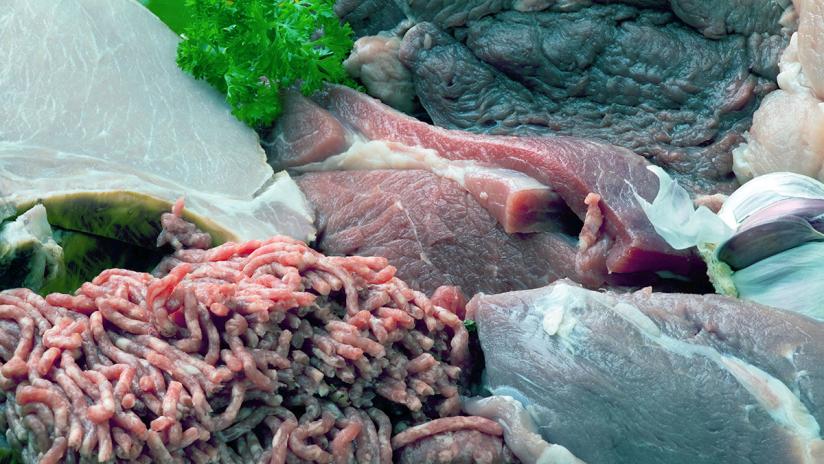Beef changes color in the fridge due to oxidation and exposure to air. This is a natural process and not harmful.

Understanding why beef changes color in the fridge is essential for proper meat storage. Fresh beef is usually bright red but can turn brown or gray after a few days. This color change occurs because of oxidation and the exposure of myoglobin, a protein in the meat, to air.
While this may seem alarming, it does not necessarily mean the beef has gone wrong. Proper storage techniques, such as keeping beef in airtight containers and maintaining the right fridge temperature, can help preserve its quality. Always check for other signs of spoilage, like a foul odor or slimy texture, to ensure your meat is safe to eat.

Credit: fridge.com
Introduction To Meat Color Changes
Beef stored in the fridge often changes color. Understanding why helps keep it fresh. This blog section will explain why beef changes color.
Color Expectations
Fresh beef should be bright red. This color means the meat is fresh. When beef turns brown, it might seem spoiled. But this isn’t always true.
Initial Appearance
When you first buy beef, it looks red. This color comes from oxygen reacting with myoglobin. Myoglobin is a protein in the meat.
Here are some typical color changes:
- Bright red: Fresh and safe to eat.
- Brown: Still safe if stored properly.
- Green or rainbow hues: Spoiled and unsafe.
| Color | Meaning |
|---|---|
| Bright Red | Fresh and safe |
| Brown | Still safe if stored right |
| Green or Rainbow | Spoiled and unsafe |
Meat color can change in the fridge. This is a natural process. It does not always mean the meat is terrible.
Factors Affecting Beef Color
Beef changes color in the fridge due to various factors. Understanding these factors helps in proper meat storage. This section explores the critical influences on beef color.
Oxygen Exposure
Oxygen exposure significantly affects beef color. When beef is exposed to air, a chemical reaction occurs. This reaction causes the meat to turn red. This red color is due to a protein called myoglobin. Myoglobin reacts with oxygen, creating a bright red color.
If the meat is not exposed to air, it can look purple. This color change is average and safe. Ensure the beef is stored correctly to manage oxygen exposure.
Temperature Fluctuations
Temperature fluctuations can cause the beef color to change. Beef should be stored at a consistent temperature. Fluctuations can lead to color changes and spoilage.
Keep your fridge steady, around 34-40°F (1-4°C). Sudden temperature changes can affect the beef’s appearance and safety.
Avoid opening the fridge door frequently. This helps maintain a consistent temperature. Proper storage ensures that your beef stays fresh and safe to eat.
Role Of Myoglobin
Beef changes color in the fridge due to myoglobin. This protein is in the muscle cells of the meat. Its main job is to store oxygen. Understanding myoglobin can help explain the color changes in beef.
Myoglobin Function
Myoglobin is a protein found in meat. It stores and carries oxygen to muscle cells. This protein binds with oxygen, giving meat its red color.
When beef is exposed to air, myoglobin reacts with oxygen. This reaction forms a bright red color called oxymyoglobin. This is often seen in fresh meat.
Impact On Color
Beef changes color due to myoglobin’s reaction with oxygen. Freshly cut beef appears bright red. This is because of the oxymyoglobin on the surface.
Over time, beef turns brown or gray. This color change happens as the oxygen supply is reduced. The myoglobin changes to metmyoglobin, causing a brown color.
| Color | Myoglobin State | Reason |
|---|---|---|
| Bright Red | Oxymyoglobin | Exposure to oxygen |
| Brown/Gray | Metmyoglobin | Reduced oxygen supply |
Cold temperatures in the fridge slow down the reaction. This helps in keeping the beef red for a longer time. But, over time, all meat will change color. Understanding myoglobin helps to know why this happens.

Credit: blog.foodsafety.com.au
Oxidation And Beef Color
Have you ever noticed your beef turning brown in the fridge? This color change can be surprising. It’s all due to oxidation.
Understanding oxidation helps you know if your beef is still safe to eat. Let’s dive into the science of oxidative changes and color transitions in beef.
Oxidative Changes
Oxidation happens when beef is exposed to air. Oxygen interacts with the meat’s pigments. This changes its color.
Fresh beef has a bright red color. This is due to a protein called myoglobin. When myoglobin meets oxygen, it turns red.
Over time, the myoglobin oxidizes. This process turns the beef brown. This is normal and does not mean the beef is spoiled.
Color Transitions
Beef goes through several color stages. Each stage tells you something about its condition.
- Bright Red: Indicates fresh beef with good oxygen levels.
- Brown: It shows oxidation, but the beef is still safe.
- Gray or Green: Suggests spoilage. Do not eat.
Storage conditions also affect beef color. Keep beef in airtight packaging. This reduces oxidation and keeps your meat fresh longer.
Understanding these color transitions helps you store beef safely. Proper storage ensures your beef stays fresh and tasty.
Impact Of Storage Conditions
Understanding how storage conditions affect beef color is essential. These conditions play a significant role in maintaining the freshness and safety of the meat.
Refrigeration Effects
Refrigeration slows down bacterial growth on beef. The cold temperature helps keep the meat fresh.
Beef stored in the fridge may change color. This change is normal. Oxygen exposure causes beef to turn red. Over time, it may turn brown or gray.
Temperature fluctuations in the fridge can affect beef color. Keeping a steady temperature below 40°F (4°C) is crucial.
Packaging Methods
Packaging methods impact beef color and freshness. Different types of packaging offer different levels of protection.
- Vacuum Sealed: This method removes air, slowing oxidation. Beef stays red longer.
- Modified Atmosphere Packaging (MAP) uses gases to preserve color. Beef looks fresh and red.
- Plastic Wrap: Allows some air exposure. Beef may turn brown faster.
Proper packaging keeps beef fresh longer. It also maintains its appealing color.
Always check the packaging date. Use beef within the recommended time.
| Packaging Method | Effect on Beef Color |
|---|---|
| Vacuum Sealed | Stays red longer |
| Modified Atmosphere | Maintains red color |
| Plastic Wrap | Turns brown faster |
Safe Storage Practices
Storing beef in the fridge can be tricky. Understanding safe storage practices ensures your meat stays fresh and safe to eat. Here, we will discuss the best methods to store beef.
Optimal Temperatures
Keeping beef at the right temperature is crucial. The fridge should be set to below 40°F (4°C). This temperature slows down the growth of harmful bacteria. Use a thermometer to check your fridge’s temperature.
For longer storage, freeze the beef. Set the freezer to 0°F (-18°C) or lower. This keeps the beef safe for several months.
Proper Wrapping
Wrapping beef properly prevents spoilage. Use plastic wrap or aluminum foil. Cover the beef tightly to limit air exposure. This helps maintain freshness and color.
Avoid using store packaging for long-term storage. Transfer the beef to airtight containers or heavy-duty freezer bags. Label the packages with the date for easy tracking.
| Storage Method | Recommended Temperature | Duration |
|---|---|---|
| Fridge | Below 40°F (4°C) | 3-5 days |
| Freezer | 0°F (-18°C) or lower | 6-12 months |
Follow these optimal temperatures and proper wrapping techniques to ensure safe beef storage. These practices keep your meat fresh and delicious.
Identifying Spoilage
Beef can change color in the fridge. This change can be natural. But it’s important to know if the beef has spoiled. Spoiled beef can make you sick. Learn how to identify spoiled beef.
Signs Of Spoilage
Look for these signs to know if beef is spoiled:
- Color Change: Fresh beef is bright red. Spoiled beef turns brown or gray.
- Smell: Fresh beef has a slight smell. Spoiled beef smells sour or like ammonia.
- Texture: Fresh beef is firm and moist. Spoiled beef feels sticky or slimy.
When To Discard
Knowing when to discard beef is vital. Follow these simple rules:
| Condition | Action |
|---|---|
| Beef smells bad | Discard it |
| Beef feels slimy | Discard it |
| Beef is brown or gray | Check other signs. Discard if unsure. |
Always trust your senses. If beef looks, smells, or feels off, throw it away.
Maintaining Beef Quality
Understanding why beef changes color in the fridge can help you maintain its quality. Proper storage practices ensure your meat stays fresh and safe to eat. Let’s dive into the best ways to keep your beef in top condition.
Quality Preservation
Beef changes color because of oxygen exposure. Fresh beef is red due to a pigment called myoglobin. When exposed to air, myoglobin turns bright red. With time, it can turn brown or gray. This color change doesn’t always mean spoilage. But, it is a sign to check for other spoilage indicators like smell and texture.
| Stage | Color | Action |
|---|---|---|
| Fresh | Bright Red | Safe to eat |
| Exposed to Air | Brown/Gray | Check for spoilage |
| Bad | Dark Brown/Green | Discard |
Best Practices
To maintain beef quality, follow these best practices:
- Store beef in the coldest part of the fridge.
- Keep beef in airtight packaging to limit air exposure.
- Use beef within 3-5 days of purchase for optimal freshness.
- Check for signs of spoilage before cooking.
By following these tips, you can keep your beef fresh and safe. Understanding beef color changes helps you make informed decisions.

Credit: fridge.com
Frequently Asked Questions
Why Does Beef Change Color in the Fridge?
Beef changes color in the fridge due to oxygen exposure. Fresh beef appears red, but turns brown as it oxidizes. This is normal and safe.
Is It Normal for Meat to Change Color?
Yes, it is normal for meat to change color. Fresh meat can turn brown due to oxidation. This color change doesn’t always indicate spoilage. Always check for other signs of freshness like smell and texture.
Does Discolored Meat Mean It Bad?
Discolored meat isn’t always bad. Color changes can occur due to oxidation. Check for off smells and slimy texture.
Why is My Meat Turning Grey in the Fridge?
The meat turns grey in the fridge due to oxidation. Lack of oxygen exposure causes color change. It’s still safe to eat if it smells fine and is within the expiry date.
Conclusion
Understanding why beef changes color in the fridge helps ensure safe meat storage. Color shifts are natural due to oxidation. Always check for spoilage signs before consumption. Proper storage preserves meat quality and safety. Stay informed about food storage to enjoy fresh and safe meals.


GIPHY App Key not set. Please check settings